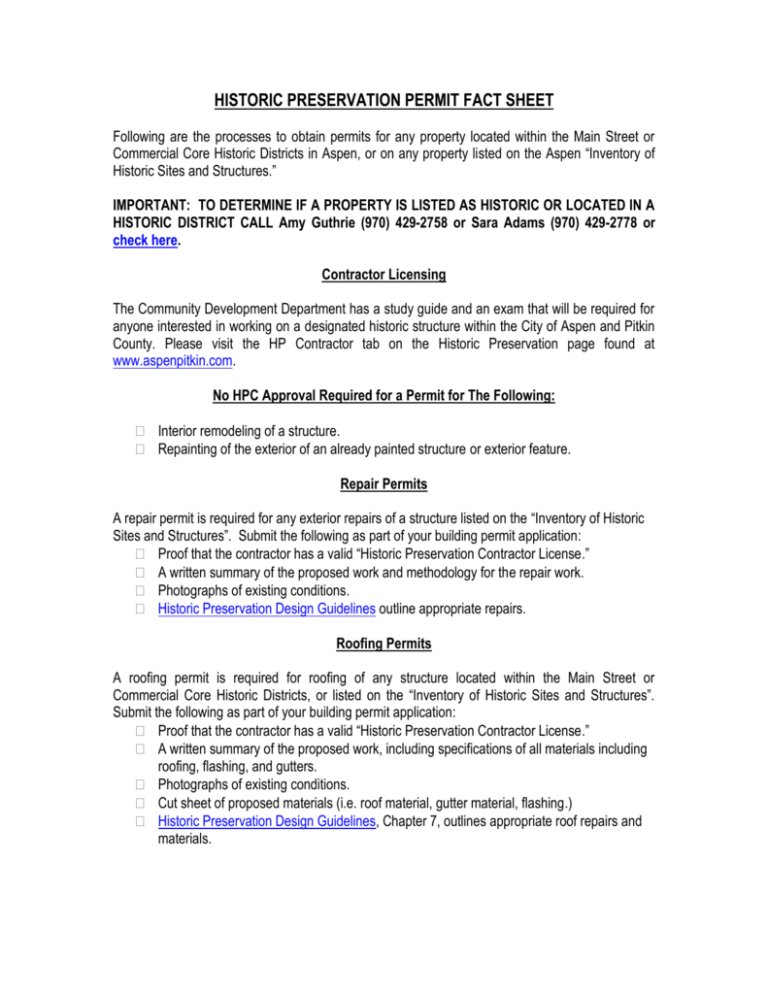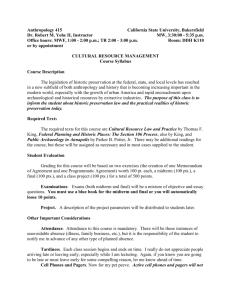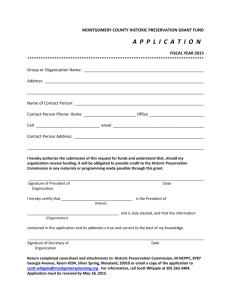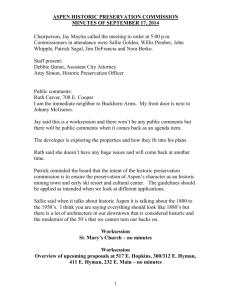HPC Fact Sheet - City of Aspen
advertisement

HISTORIC PRESERVATION PERMIT FACT SHEET Following are the processes to obtain permits for any property located within the Main Street or Commercial Core Historic Districts in Aspen, or on any property listed on the Aspen “Inventory of Historic Sites and Structures.” IMPORTANT: TO DETERMINE IF A PROPERTY IS LISTED AS HISTORIC OR LOCATED IN A HISTORIC DISTRICT CALL Amy Guthrie (970) 429-2758 or Sara Adams (970) 429-2778 or check here. Contractor Licensing The Community Development Department has a study guide and an exam that will be required for anyone interested in working on a designated historic structure within the City of Aspen and Pitkin County. Please visit the HP Contractor tab on the Historic Preservation page found at www.aspenpitkin.com. No HPC Approval Required for a Permit for The Following: Interior remodeling of a structure. Repainting of the exterior of an already painted structure or exterior feature. Repair Permits A repair permit is required for any exterior repairs of a structure listed on the “Inventory of Historic Sites and Structures”. Submit the following as part of your building permit application: Proof that the contractor has a valid “Historic Preservation Contractor License.” A written summary of the proposed work and methodology for the repair work. Photographs of existing conditions. Historic Preservation Design Guidelines outline appropriate repairs. Roofing Permits A roofing permit is required for roofing of any structure located within the Main Street or Commercial Core Historic Districts, or listed on the “Inventory of Historic Sites and Structures”. Submit the following as part of your building permit application: Proof that the contractor has a valid “Historic Preservation Contractor License.” A written summary of the proposed work, including specifications of all materials including roofing, flashing, and gutters. Photographs of existing conditions. Cut sheet of proposed materials (i.e. roof material, gutter material, flashing.) Historic Preservation Design Guidelines, Chapter 7, outlines appropriate roof repairs and materials. Mechanical Permits A mechanical permit is required for exterior equipment on any property located within the Main Street or Commercial Core Historic Districts, or listed on the “Inventory of Historic Sites and Structures”. Submit the following as part of your building permit application: Proof that the contractor has a valid “Historic Preservation Contractor License” (Only for work on historic buildings.) A written summary of the proposed work. A roof plan or elevation (depending on the location of the equipment), to scale, indicating all existing and proposed mechanical equipment. A section, to scale, indicating all existing and proposed mechanical equipment. Photographs of existing conditions. Elevations and material samples (a photograph is fine) of proposed screening for the mechanical equipment. Historic Preservation Design Guidelines, Chapter 14, outlines appropriate screening and locations for mechanical equipment. Fence Permits A fence permit is required for any property located within the Main Street or Commercial Core Historic Districts, or a structure listed on the “Inventory of Historic Sites and Structures”. Submit the following as part of your building permit application: A survey indicating where the fence will be located. An elevation showing the design and materials to be used for the fence. o Please refer to the Historic Preservation Design Guidelines Chapter 1 for guidance on fence design and material, and landscaping. Photographs of existing conditions. Sign Permits A sign permit is required for any property located within the Main Street or Commercial Core Historic Districts, or a structure listed on the “Inventory of Historic Sites and Structures”. Submit the following with your sign permit: A site plan or building elevations indicating where the sign will be located. A drawing, to scale, showing the design, lighting and materials to be used for the sign. Detailed information about how the sign will be attached to the structure or to the ground if it is a freestanding sign. Photographs of existing conditions. Historic Preservation Design Guidelines, lists guidelines for Main Street and the Commercial Core, see Chapters 12 and 13 respectively. Please refer to the Land Use Code Sign Chapter for regulations. Electric Permits An electric permit is required for any exterior light fixtures on any structure located within the Main Street or Commercial Core Historic Districts, or a structure listed on the “Inventory of Historic Sites and Structures”. Submit the following: A site plan or building elevations indicating where the lighting will be located. A drawing, to scale, showing the design and materials to be used for the light. Detailed information about how the light will be attached to the structure or to the ground if it is a freestanding light. Information on the wattage and type of bulb in all fixtures. Photographs of existing conditions. Historic Preservation Design Guidelines, Chapter 14, lists guidelines for light fixtures. Please refer to the Aspen Land Use Code Section 26.575.150 Outdoor Lighting. Building Permits A building permit is required for any property located within the Main Street or Commercial Core Historic Districts, or a structure listed on the “Inventory of Historic Sites and Structures”. Submit the following with your building permit application: A resolution of the Aspen Historic Preservation Commission approving the work printed on the cover of the permit drawing set. Proof that the contractor has a valid “Historic Preservation Contractor License.” Elevations, site plans, sections, details, or other graphic information as approved by the Historic Preservation Commission. Verification that any amendments to the project since the time of the Historic Preservation Commission decision have been approved. A letter from the contractor stating that he/she has read and understands all of the conditions of approval placed on the project by the Historic Preservation Commission. Any other items that the Historic Preservation Commission resolution requires to be provided at building permit submittal. Permits should not be submitted with unapproved changes. Temporary Relocation Permits A building relocation permit is required for any structure listed on the “Inventory of Historic Sites and Structures” that is to be lifted and/or moved. Submit the following with your building permit application: A resolution of the Aspen Historic Preservation Commission approving the work printed on the cover of the permit drawing set. Proof that the contractor has a valid “Historic Preservation Contractor License.” A temporary storage plan showing how and where the building will be placed during the relocation activity. The building will be required to be secured, with plywood over all doors and windows. A letter/drawings from the house mover or a structural engineer stating how the building will be braced for relocation. A letter of credit from the property owner in the amount specified in the Historic Preservation Commission resolution. A letter from the contractor stating that he/she has read and understands all of the conditions of approval placed on the project by the Historic Preservation Commission. Any other items that the Historic Preservation Commission resolution requires to be provided at permit submittal. Building permit for the receiving property if the building is being moved off-site. Demolition Permits A demolition permit is required for any structure located within the Main Street or Commercial Core Historic Districts, or any structure listed on the “Inventory of Historic Sites and Structures”. Submit the following with your building permit application: A resolution of the Aspen Historic Preservation Commission approving the demolition/partial demolition printed on the cover of the permit drawing set. Proof that the contractor has a valid “Historic Preservation Contractor License” if the affected building is a historic resource undergoing partial demolition. A demolition plan as approved by the Historic Preservation Commission. A letter from the contractor stating that he/she has read and understands all of the conditions of approval placed on the project by the Historic Preservation Commission. Any other items that the Historic Preservation Commission resolution requires to be provided at permit submittal.







